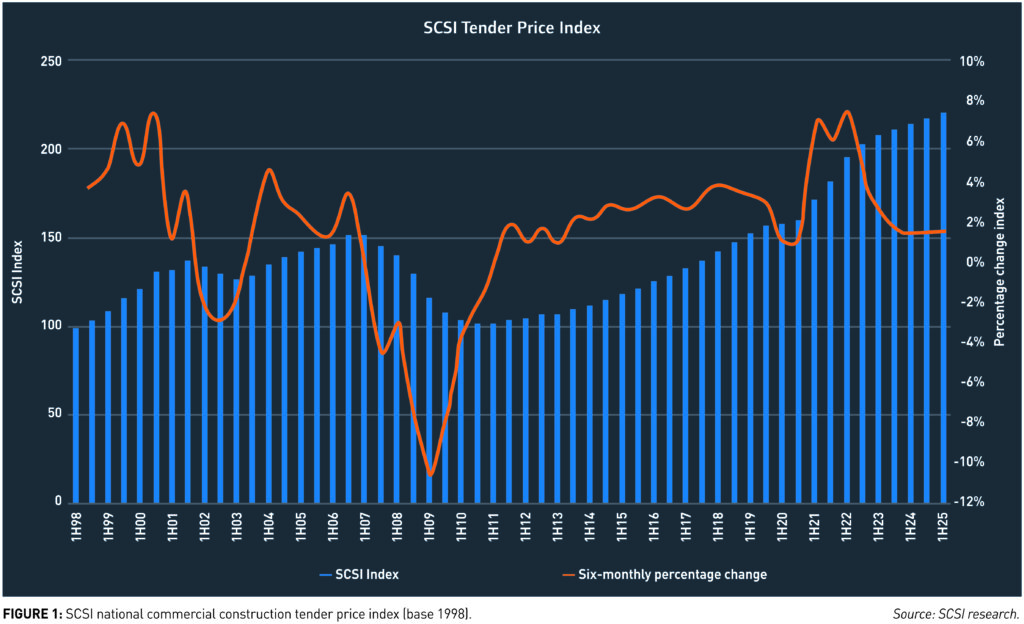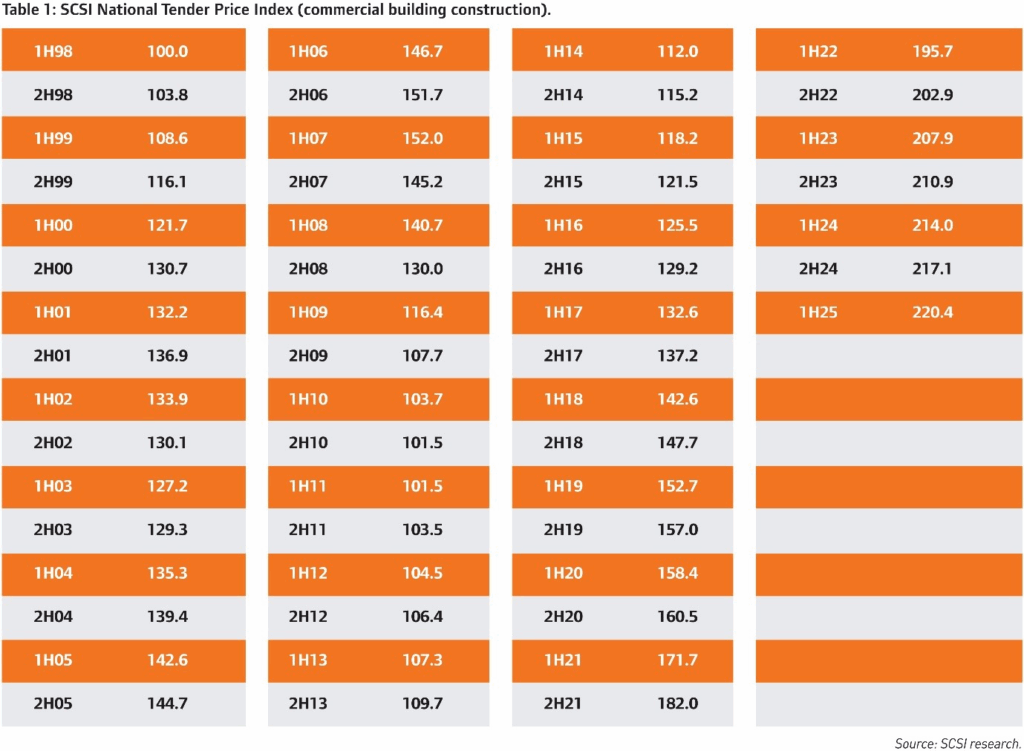The Society of Chartered Surveyors Ireland Mid-Year Commercial Property Review and Outlook Report 2025
Report indicates market is entering a transitional phase, characterised by signs of recovery alongside persistent structural challenges.
The key findings:
- Overall capital value and rental expectations for all prime commercial property asset types show positive outlook for the next 12 months
- Chartered Commercial Surveyors expect prime industrial values and rents to rise by an average of 2.5% nationally
- Prime office capital values and rents are expected to increase by 2.1% and 2.6% respectively
- Prime retail capital values are expected to rise by 1.0% and rents by 1.8% on average
- 51% of survey participants believe the market to be in some stage of recovery while 57% believe current valuations represent fair value
- Almost two thirds of agents believe businesses plan to optimise their office footprint
- A similar number believe occupiers are prepared to pay for enhanced health and well-being features
Thursday, August 28th 2025: Occupier sentiment in commercial property has continued to improve over the first half of 2025, with chartered commercial and valuation surveyors predicting a rise in rents and capital values across prime commercial property asset types over the next 12 months.
As has been the case in recent years, both prime and secondary industrial properties continue to be the standout performers, driven by high demand for logistics and distribution spaces.
The Society of Chartered Surveyors Ireland Mid-Year Commercial Property Review and Outlook Report 2025 predicts that national average capital values and rents for prime industrial will rise by 2.5% over the next 12 months.
Chartered commercial and valuation surveyors expect prime office capital values and rents to increase by 2.1% and 2.6% respectively, while they believe prime retail capital values will increase by 1.0% and rental values by 1.8% on average.
The President of the SCSI, Gerard O’Toole, said that while the market is continuing to face structural headwinds, it is showing tentative signs of stabilisation and improvement.
“We are seeing resilience in key areas particularly in the industrial segment, where demand remains robust, and in prime office and retail assets where quality and location are driving selective growth.”
“Of course, challenges remain. These include subdued investor activity due to ongoing global uncertainty, changing work patterns and evolving consumer behaviour. However, the overall sentiment is one of measured confidence.”
Two years ago in the corresponding survey, a majority of respondents, 61%, viewed the market as expensive or very expensive. In this survey, that figure dropped to 31% while the proportion viewing valuations as fair value increased to 57%.
In addition, 51% of respondents perceive the market to be in some stage of recovery or upswing, with 33% identifying early recovery and 18% mid-upturn.
Mr O’Toole said these findings suggest that sentiment has shifted towards cautious optimism with most participants anticipating further recovery rather than renewed decline.
“Combined with previous sentiments of more stable credit conditions and valuations being viewed as closer to fair value, the market appears to be in an early recovery phase, with potential for continued capital appreciation alongside moderate rental growth.”
“While the recently finalised US/EU trade deal has removed a significant source of international uncertainty, questions remain over the long-term implementation and impact of the agreement.”
Sectoral Analysis
For prime industrial properties, 50% of surveyors expect the capital value to increase and 51% anticipate an increase in rental values while the number forecasting, they will remain the same are 40% and 44% respectively.
In contrast, for secondary industrial properties, only 34% expect capital values to increase, and 42% expect rental prices to rise. However, a significant portion, 57% for capital and 44% for rental, respectively, expect prices to remain the same.
Fifty-four percent of surveyors expect that the capital value of prime offices will increase, while 33% expect it to remain the same. In terms of rent for the prime office, 56% of surveyors anticipate an increase, whereas 34% expect the rent to stay the same.
Regarding secondary offices, only 14% of surveyors expect the capital value to rise, while the number forecasting a rise in rent is just 21%, with 81% anticipating that rental prices will stay the same or decrease. While 47% expect capital values to remain the same, 39% believe they will fall. The respective figures for rent are 42% and 37%.
For prime retail spaces, 34% of surveyors expect capital values to increase over the next 12 months, while 48% anticipate an increase in rental values. However, a majority, 59% for capital and 45% for rental, believe these values will remain the same.
In contrast, for secondary retail spaces, just 16% of surveyors expect capital values to increase, 52% believe they will remain unchanged and 32% believe they will decrease. The corresponding figures for rents are 18%, 57% and 25%.
Commentary
Bernadine Hogan, chair of the Commercial Agency Committee, said the findings underscore the industrial sector’s dominance in current market dynamics, steady but cautious progress in offices and continued stabilisation in retail.
“Industrial continues to lead the way, although the sentiment towards secondary industrial assets is more restrained. The office sector also exhibits overall growth reflecting ongoing recovery in prime office markets despite challenges in secondary spaces where sentiment is notably weaker.”
“By contrast, according to the survey, retail continues to show a varied performance. While prime retail locations remain relatively stable and are experiencing modest growth as they adapt to evolving consumer habits and demand, secondary more regional assets are facing ongoing challenges.
Ms Hogan noted that chartered surveyors identified strong growth prospects in sectors focused on essential services and residential development, while the hospitality sector was described as comparatively subdued.
“Student housing stands out with the highest projections, anticipating rental growth of 4.5% and capital value appreciation of 4.9%, driven by strong demand and constrained supply.”
“Aged care facilities also exhibit strong fundamentals, with rental growth projected at 4% and capital values rising by 4.4%, reflecting demographic trends and the need for specialised care assets.”
“Hotels are forecasted to have the most modest growth, with rental increases of just 1.9% and capital values slightly lower at 2.1%, indicating a cautious recovery in the hospitality sector.”
Future Trends
The survey findings indicate that a substantial proportion of businesses are likely to optimise their office real estate footprint over the next two years. Almost two-thirds of agents believe businesses’ may scale back their office footprint slightly while 36% do not anticipate any reduction.
Ms Hogan believes these findings reflect a move towards modern, higher quality and more sustainable offices.
“Occupiers seeking to reduce space are likely to consolidate into higher-quality, well-located offices, thereby exerting additional pressure on secondary properties facing weaker demand. “
A substantial majority (86%) of chartered surveyors believe that tenants will increasingly demand enhanced health and well-being features in the real estate they occupy going forward, with 68% expecting that occupiers will be prepared to pay a premium for such facilities.
Ms Hogan said it’s clear the emphasis going forward will be on enhanced facilities and sustainability.
“In a market characterised by a national commercial vacancy rate of 14.5%, tenants are in a strong negotiating position. As such, assets offering amenities such as fitness and outdoor spaces, strong sustainability credentials, and adaptable layouts are likely to command a more competitive position.”
For media queries please call the SCSI at (01) 6445500 and ask for Patrick King.
Note to Editor
The SCSI Mid-Year Commercial Property Review and Outlook Report 2025 is informed by surveys completed in June/July 2025 by Chartered Commercial and Valuation Surveyors. The report provides net balance index charts illustrating surveyor sentiment on market trends. Net balance is calculated by taking the total number of “increase” responses from “decrease” responses and displaying the result. The index charts provided are unweighted composite measures capturing overall market momentum, encompassing variables on supply, demand, and expectations. A total of 100 responses informed the latest figures within this report.




